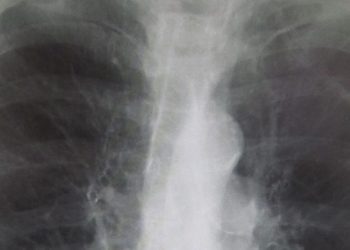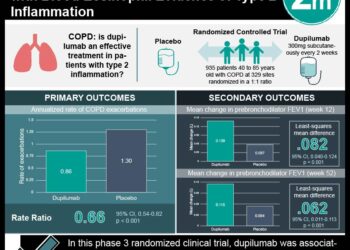Expiratory central airway collapse associated with poor quality of life
1. Expiratory central airway collapse is associated with chronic obstructive pulmonary disease and a poorer quality of life.
2. However, expiratory central airway collapse is not associated with all-cause mortality.
Evidence Rating Level: 3 (Average)
Study Rundown: It is well known that patients with chronic obstructive pulmonary disease (COPD) have a high prevalence of respiratory morbidity, and that chronic smoking is inherently linked to the development and severity of the disease. While expiratory central airway collapse (ECAC) is a known pathophysiological feature of COPD, its clinical significance and prevalence were not clear. Thus, this study utilized chest CT scans to determine which patients experienced ECAC, and correlated this phenomenon with clinical features. Among patients with COPD, 5% were found to have ECAC. Airway collapse was associated with worse respiratory symptoms, worse quality of life, and a higher frequency of COPD exacerbations requiring hospitalization. Furthermore, ECAC was more common in patients who were female, white, had a higher BMI, and had higher stages of COPD.
This study benefited by a large sample number and a broad range of demographic features among the enrolled patient population. Additionally, the inter-reader variability regarding the diagnosis of ECAC on CT scans was low, strengthening the findings of the study. However, this study was not set up to answer the question of how the average clinicians could use this finding to help guide management of these patients, and more research about the clinical utility of this finding is required.
Click to read the study, published today in JAMA
Relevant Reading: Review of adult tracheomalacia and its relationship with chronic obstructive pulmonary disease
In-Depth [cross-sectional study]: This cross-sectional analysis examined inspiratory and expiratory CT images of 8820 current and former smokers aged 45-80 years, to determine the prevalence and clinical significance of ECAC. Patients with known lung disorders other than asthma and COPD were excluded. Primary outcomes included measures of respiratory disease-related health impairment and quality of life, which were assessed through a validated questionnaire. Secondary outcomes included dyspnea, exercise capacity, exacerbation frequency, and all-cause mortality. Collapse of the airways was positive if there was at least a 50% reduction in cross-sectional area of the airway at end-expiration.
Five percent of all participants demonstrated radiographic ECAC, with a higher prevalence in patients with COPD (5.9% vs. 4.3%, 95%CI 0.9% to 2.7%, p < 0.001). Participants with ECAC were more likely to be white, female, have a higher BMI, emphysema, and a higher Gold stage of COPD at the time of the study. These participants also reported a much worse quality of life (SGRQ score 30.9 vs. 26.5, p < 0.001), and had a higher incidence rate ratio of severe COPD exacerbations (IRR 1.39, 95%CI 1.08 to 1.78, p = 0.01). There was no difference in the 6-minute walk test or in all-cause mortality between the two groups.
Image: PD
©2016 2 Minute Medicine, Inc. All rights reserved. No works may be reproduced without expressed written consent from 2 Minute Medicine, Inc. Inquire about licensing here. No article should be construed as medical advice and is not intended as such by the authors or by 2 Minute Medicine, Inc.






![Oral amoxicillin as effective as injectable benzylpenicillin-gentamicin for infants with infection in which referral not possible [AFRINEST Trial]](https://www.2minutemedicine.com/wp-content/uploads/2015/04/NOVAMOXIN_antibiotic-75x75.jpg)